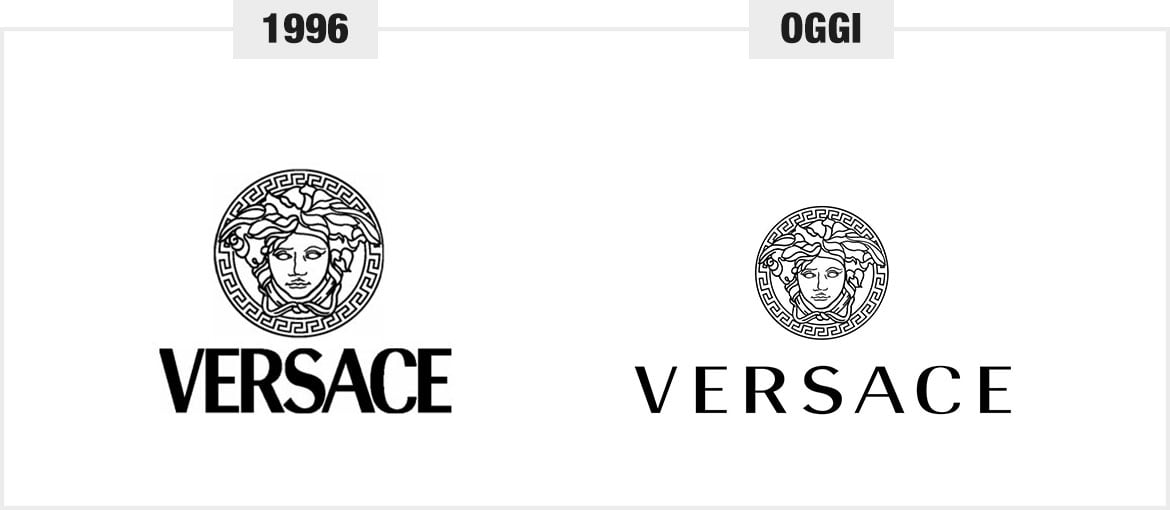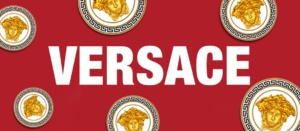He was extravagant, unscrupulous, with an unbridled passion for sophisticated fabrics. In 1995 Time magazine anointed him the man of the moment.
His creations were worn by the most famous supermodels: Naomi Campbell, Linda Evangelista, Claudia Schiffer, Carla Bruni, Cindy Crawford. Off the catwalk, stars such as Elton John, Bon Jovi, Sylvester Stallone, Madonna, Cher have chosen his clothes. An exhibition at the Metropolitan Museum of Art in New York in 1998 and an exhibition at the Victoria and Albert Museum in London in 2002 were dedicated to his brand.
Here we talk about a brand that is a symbol of Italian high fashion: Versace. Let’s review the history of its different and unmistakable logo.
The Versace fashion house
If you already know the history of the company, you can move on to the next paragraph where we get straight to the point. In fact, to the logo. If, on the other hand, you are curious to find out how the great maison was born and how it developed, here let’s quickly retrace its history.
It was the year 1972 when the ambitious Gianni Versace left Calabria and moved to Milan to design a collection for the Florentine Flowers company. The collection was a great success and soon after came other important collaborations with Callaghan, Complice and Genny. In the meantime, the desire to create his own label that would represent the man, designer and entrepreneur Gianni Versace in every way was consolidated. Thus, in 1978, the first collection signed by the designer was born. In 1988 his younger sister Donatella also joined the company with the direction of the Versus brand, Versace’s young line.
So much has been written and talked about the “Versace tragedy,” on Netflix you can even find a TV series, “The Assassination of Gianni Versace,” which traces the heinous murder that took place on July 15, 1997. On that day, Gianni Versace was murdered by serial killer Andrew Cunanan in his Miami Beach mansion. The killer committed suicide eight days after his capture.
Following the designer’s death, the company faced a deep crisis. The event also marked a wound for the brand’s name: the name Gianni disappeared and only the surname remained: Versace. The designer’s legacy is carried on, even today, by Donatella Versace, who serves as the creative director of the fashion house.
Versace logo: how it has changed over time
In 1980, two years after the brand was founded, Gianni Versace presented the first logo chosen for his fashion house, perhaps some of you still remember it.

The font used is Avant Garde light, the text is compacted and the letters come closer to each other as if to form the links of a chain. Look, for example, at how the “c” and “e” interpenetrate. The effect is certainly elegant. In 1990, the font was replaced with a “Radiant medium,” which is very different from its predecessor: the sign is cleaner but, above all, it is more incisive and marked, intended to emphasize a strong and established identity.

What about the iconic Medusa head? For that one has to wait for the logo launched in 1993.

From this time on, the Versace logo has undergone only minor changes, lightened the thickness of the letters and increased the spacing. The image of Medusa’s head, however, has remained almost the same, as if to emphasize its classicism. And even when it does not accompany the logo, the Medusa is always present: take a look at Versace‘s website and you will find it everywhere.

The Medusa and its significance
But why did Gianni Versace specifically choose the image of the Medusa? The choice is undoubtedly singular.
Let’s start with an anecdote: Gianni Versace grew up in Rome, a city steeped in history and myth. The first time he saw the figure of Medusa he was just a child, he saw her depicted on the floor of an ancient Roman mansion where he was playing with his brothers. For some reason, that image struck him even before he discovered its story and remained etched in his memory.
Now, let us briefly recall the myth: the story tells of the beautiful Medusa seducing Poseidon in the temple of Athena, arousing all his wrath. Athena retaliates by turning Medusa into a fearsome monster with snake hair and fangs instead of teeth. From then on, her gaze will petrify anyone who lays eyes on her.
This story tells us about two vices: lust and vanity. Without these two vices, the world of fashion would not exist. We do not know if this choice was made consciously by Gianni Versace, thus with a hint of irony, or if it is just the result of a nostalgic memory. What is certain, however, is that this image carries with it a symbolic universe that we cannot ignore:
- There is the homage to the glorious civilizations of the Mediterranean, a legacy also visible in the rich and sumptuous style of Gianni Versace’s clothes.
- There is the mythological figure of Medusa, as seductive and alluring as fashion must be.
- There is lust and vanity, two themes intrinsically linked to the world of luxury.
Moreover, let us not forget that the Medusa is also an auspicious symbol: it comes from the Greek Μέδουσα and means protector, guardian. Therefore, the symbol was meant to be a good omen for a glorious future of the fashion house. And perhaps there was also something more behind the decision to tie the myth to its brand: the desire to make its collections timeless, “mythological” in fact.

